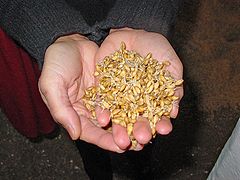Barley
| Infobox on Barley | |
|---|---|
| Example of Barley |  |
| Facts | |
| Origin | This Table shows only a selection of the most important countries of origin and should not be thought of as exhaustive
|
| Stowage factor (in m3/t) |
|
| Angle of repose | Approx. 25° (average value) |
| Humidity / moisture |
|
| Oil content | The oil content of barley is approx. 2%. |
| Ventilation | Recommended ventilation conditions: surface ventilation (see text). |
| Risk factors | An excessively high water content may result in self-heating due to increased respiratory activity. |
Barley
Description
Barley (Hordeum vulgare) is a type of cereal belonging to the grass family (Gramineae), the term "cereals" covering the grain fruits of cultivated grasses (spikes or ears in the case of wheat, rye, barley and corn; panicles in the case of oats and rice.
Barley is grown mainly in the summer, but also in the winter. Barley ears have awns some 15 cm in length growing from them.
The structure and chemical composition of the grain vary little between the different types of cereal. The cereal grain is a single-seeded indehiscent fruit, the husk of which is formed by the fusion of the fruit and seed walls. It consists of three components:
its cracked husk, which gives the grain a greatly increased surface area relative to its mass. This allows the cereal grain to enter into an active exchange of materials with its environment; the endosperm, which constitutes the main component of the grain and the embryo.
After harvesting, barley usually undergoes further post-ripening, which consists of the high molecular weight substances congregating further with water being expelled (syneresis). As the surface of the cereal then becomes damp because of the elevated water content, this is described as "sweating. In this state, the cereal is highly susceptible to mold and must not as yet be shipped. However, if the water content of the cereal is relatively low (approx. 13 - 14%), proper storage allows the sweat moisture to be absorbed by the air without the risk of mold growth. This sweating process proceeds for a period of approximately 1 - 2 months.
Prior to loading, checks should be carried out by an independent inspector and a certificate provided in relation to loading moisture content, the absence of odor and contamination and the absence of pests.
Excessively damp and incompletely ripened goods may be liable to self-heating, elevated respiratory activity, mold growth and fermentation during transport.
Barley which is "dry for shipment" may be kept for up to 12 months or longer provided that the appropriate temperature, humidity/moisture and ventilation conditions are complied with.
Applications
Winter barley is used primarily as an animal feedstuff while summer barley is mainly used to make malt (sprouted barley grains) for beer and coffee substitute and as a breadstuff.
Shipping/storage
Barley is mainly transported as bulk cargo and only sometimes in bags (seed).
Mainly in bulk containers, but also as bagged cargo (e.g. seed) in standard containers. Compliance with limits for the water content of the cargo and container floor must be ensured.
In damp weather (rain, snow), the cargo must be protected from moisture, since wetting and extremely high relative humidities may lead to mold growth, spoilage and self-heating due to increased respiratory activity.
Suction and blowing devices may cause not inconsiderable damage to the grains.
Grain size
Diameter 1 mm, length 8 mm
Stowage space requirements Cool, dry, good ventilation.
In the case of maritime transport, the IMO (International Maritime Organization) "Code for Safe Carriage of Grain in Bulk" must be complied with.
When loading an ocean-going vessel with several types of cereal, heavy cereals (wheat, rye, barley, corn) must be stowed in the lower part of the hold and lighter cereals (oats, millet) in the upper part of the hold, for reasons of stability.











